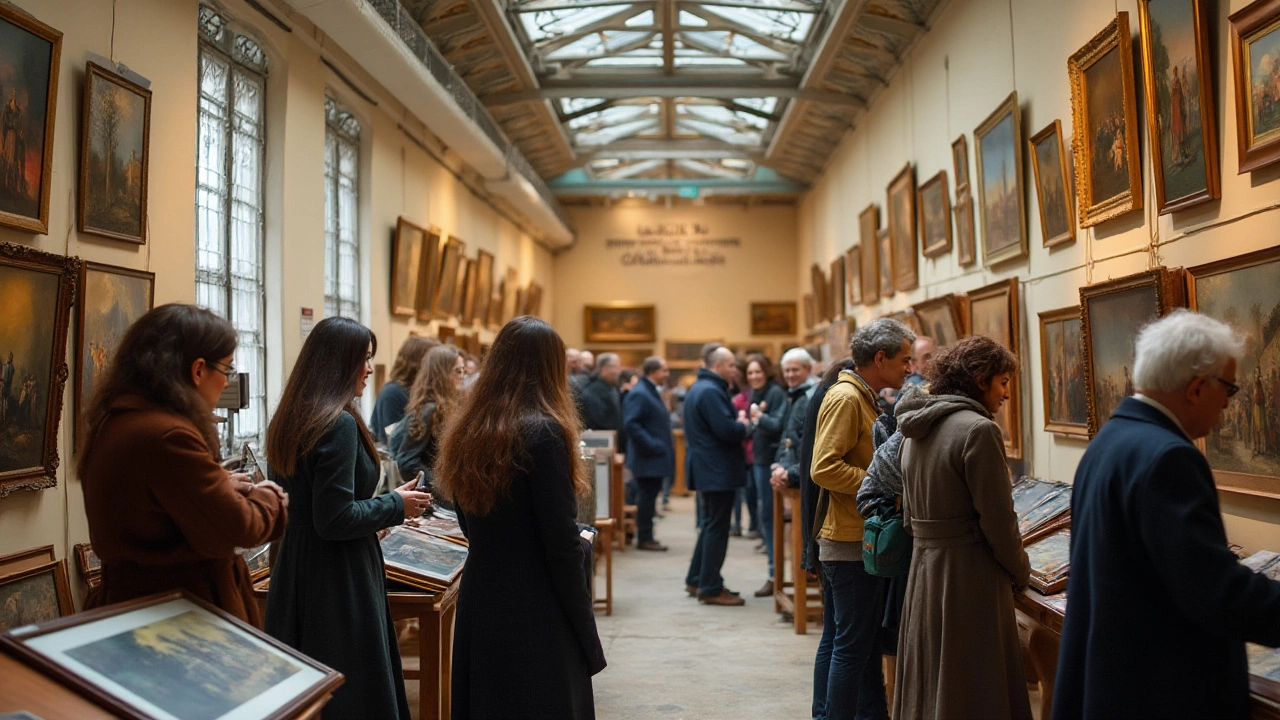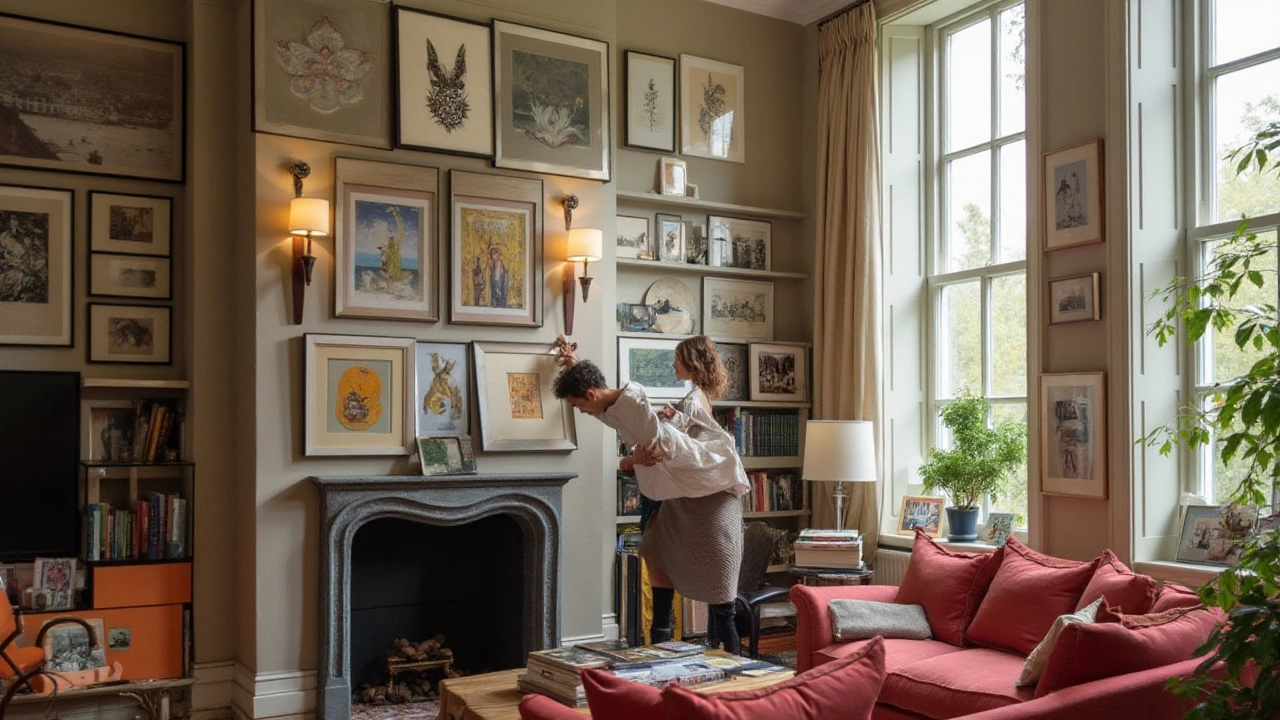Embarking on the journey of collecting art prints is as much about self-discovery as it is about aesthetics. Imagine wandering through a gallery, or browsing online, when suddenly a piece captivates your imagination. It's the start of a collection that not only decorates your home but also tells a story about who you are.
While knowing your taste is a crucial first step, setting a budget keeps your passion grounded. A collector can dive into the world of art prints through numerous channels, understanding what works for one's personal space. Delve into artists' backgrounds, learn to differentiate styles, and grasp the basics of where and how to acquire genuine pieces.
Framing isn't just about protection; it's about enhancing the experience of art. And when it comes to displaying your collection, let creativity lead the way. From carefully crafted gallery walls to single statement pieces, each setup contributes to the overall ambiance. Collecting art prints can be a fulfilling adventure, offering endless creative expression.
- Discovering Your Artistic Taste
- Setting a Realistic Budget
- Exploring Various Art Print Sources
- Understanding Artists and Styles
- The Importance of Framing
- Displaying Your Art Collection
Discovering Your Artistic Taste
Embarking on the adventure of collecting art prints begins with unraveling the layers of your personal taste, an exploration that speaks volumes about your identity and artistic inclinations. The world of art is vast and varied, encompassing myriad styles, genres, and eras. To pinpoint what resonates with you, it might help to wander through galleries or attend exhibitions spontaneously; pay attention to what draws you in and stirs emotion. Often, an unplanned visit becomes a touchstone moment. Besides physical spaces, the digital realm offers a treasure trove of inspiration, making for a great arena to begin your quest from the comfort of your sofa.
What captures your attention? Is it the vivid strokes and emotive power of expressionism, or does the quiet elegance of minimalism speak louder to you? Consider organizing your preferences into categories—such as abstract, contemporary, or vintage art prints—to further clarify your taste. Online tools like Pinterest or art-focused apps can assist in curating a personal digital gallery that reflects your developing aesthetic.
Collectors often find that their tastes evolve over time, influenced by experiences, stories, and new understandings. Engaging with the art community through workshops or forums can also broaden your perspective. As Claire G. Shaprio, a respected art curator, notes,
"Art transforms not only spaces but the people within them, challenging perceptions and unlocking new passions."Her words remind us that art isn’t static; it’s dynamic and ever-changing, just like our preferences.
In your journey, practical exercises like journaling your thoughts on artworks or taking notes on why a piece captivates you may prove beneficial. Ask yourself what emotions surface or what memories are invoked. Your preferences do not need to fit a mold and might surprise you. Remember Leonardo da Vinci’s insight that "Art is never finished, only abandoned," suggesting that both art and preference are conversational, ever-evolving dialogues. Was there a particular piece that left a mark? What was it that made it special to you?
While the exploration of art prints is deeply personal, community platforms like discussion panels or local art clubs play a vital role in shaping and expanding your understanding. Around 45% of new collectors report that social interaction helped refine their taste, illustrating just how much value there is in shared experiences. Harness these interactions to gain insights on various artists, styles, and trends, nurturing a richer appreciation of the art world.
Finally, curating a collection that is honest to your personal aesthetic allows your space to become a canvas in itself. Feel free to play with different placements and arrangements as you go, treating your space as a constantly evolving gallery. In the end, discovering your artistic taste is as much about self-reflection as it is about artistry, intertwining your personal narrative with the boundless stories waiting to be unfolded within each piece. Embrace the journey, and let your collection become an extension of who you are.
Setting a Realistic Budget
Starting your journey into the world of collecting art prints involves not just an appreciation for art but also a practical assessment of your finances. It is important to balance enthusiasm with financial reality, ensuring that your passion for art doesn't lead to fiscal strain. Begin by scrutinizing your disposable income and understanding how much you're willing to set aside for this endeavor. Remember, there's a difference between a purchase that feels good now and one that supports a sustainable collecting habit over time.
When setting a budget, consider why you're collecting in the first place. Is it for personal enjoyment, potential investment, or perhaps both? Each of these motivations might entail different financial commitments. It is often said, "Art is the most beautiful of all lies," reflecting how personal the value of art can be, sometimes beyond mere monetary worth. Yet, regardless of the motive, it's smart to establish both a monthly and annual budget. This structure helps prevent spontaneous purchases that could derail your finances if not planned properly.
Investing in art prints is unlike purchasing other commodities. The emotional connection you may feel with certain pieces can dictate values that are sometimes hard to quantify. However, keeping track of market trends and understanding the average prices for pieces and artists you're interested in gives you a negotiation edge. Many reputable collectors suggest allocating about 5-10% of your discretionary spending to art to maintain balance between passion and prudence. This figure, of course, must adjust according to personal circumstances and should adapt as your interest in collecting grows.
Don't forget to take into account additional costs. While the price tag on the print itself is obvious, presentation expenses like framing can also add up. Good quality frames don't just add visual appeal—they also offer protection to your prints. Sometimes, it might be worthwhile to have a reserve fund for maintenance and restoration of your collection down the line, enhancing both its monetary and sentimental value.
For more seasoned collectors, diversification can be key. Spreading your investments across different artists and styles not only enriches your collection but can also be a safer financial strategy against market volatility. As the art world constantly evolves, keeping your finger on the pulse of emerging artists can lead to valuable acquisitions, sometimes even on a budget.
Lastly, always consider seeking guidance. Art advisers and seasoned collectors can provide insights that might not be obvious at first glance. Their expertise might save you money in the long run as they can help you make educated purchases. Paul Getty, a renowned collector, once quipped, "The big collectors of our world do specialize." This advice is quite applicable to new collectors: specialize initially, understand your focused area deeply, and expand from that point with informed, budget-friendly decisions.

Exploring Various Art Print Sources
Diving into the multitude of art print sources may seem overwhelming at first, but it holds the key to discovering unique gems that resonate with you. One of the most traditional and respected places to find art prints is at galleries. Art galleries often feature curated selections of prints from well-established artists, providing a physical space where you can personally engage with the pieces. In-person visits to galleries offer the tactile sensation missing from virtual experiences, an essential aspect of truly understanding the texture and emotion of an artwork. However, times have changed, and the digital revolution has made art more accessible than ever.
Online platforms have broadened the horizon for art collectors, offering a vast array of prints from all over the world. Websites like Artsy, Saatchi Art, and Society6 have democratized the art world, making it easier for both new and seasoned collectors to find pieces from contemporary artists. They provide an opportunity to explore different categories and styles that may not be available locally. Additionally, many of these platforms offer helpful tools and guides for new collectors, making the search process more intuitive and enriching. Alongside the giants, don't overlook the potential treasures hidden in smaller, niche websites that specialize in specific genres or movements.
Art fairs and exhibitions are events that should not be missed by those eager to expand their art collection. Attending these gatherings allows collectors to engage directly with artists and learn about their processes and inspirations. It's a dynamic environment where you can immerse yourself in a cultural exchange, often leading to the discovery of new favorites. Consider checking out renowned art fairs like Art Basel or the Affordable Art Fair for a global perspective. Throughout these events, the chance to see a wide variety of styles and mediums under one roof provides invaluable insight into current trends within the art world.
For those who enjoy the hunt, antique shops and thrift stores can be a goldmine of art prints waiting to be rediscovered. These venues often have a diverse and eclectic collection of vintage and retro prints that can add a unique character to your lineup. The thrill of finding an unexpected piece in an off-the-beaten-path location adds an adventurous element to collecting. However, it’s important to be cautious and verify the authenticity of such prints, as provenance can sometimes be obscure. A keen eye and patience can lead to remarkable finds that provide a historical context to your collection.
"The art market has never been more diverse and accessible, opening new doors for collectors worldwide," notes Nathaniel Kahn, director of the documentary 'The Price of Everything'. This diversity is a boon, encouraging exploration and the development of one’s distinct art collection with fewer limitations.
Social media platforms have surged as unexpected yet powerful venues for discovering emerging artists. Instagram, in particular, serves as a virtual gallery for artists to showcase their portfolios and connect with art lovers. By following artists whose work you admire, you get direct access to their creative journeys and upcoming pieces before they hit galleries. This relationship-building aspect of social media allows for a deeper connection with the art you choose, often seeing it evolve over time from conception to completion.
If considering financial investment in art prints, it may be wise to explore auction houses such as Sotheby’s and Christie’s, where exclusive and limited edition prints become available to the discerning collector. Bidding on items can be a thrilling experience and often includes insights from experts about the pieces on offer. Online bidding now bridges geographical gaps, making this elite realm more accessible than ever. Auctions often come with added confidence regarding the authenticity and value of the pieces, though it is always recommended to conduct thorough research and consultation with experts before making substantial investments.
Understanding Artists and Styles
Diving into the world of art prints means immersing yourself in a rich tapestry of artists and styles, each offering a unique lens through which to view the world. From the bold brush strokes of expressionism to the serene simplicity of minimalism, every style brings something unique to the table. It's crucial to explore various art movements to grasp what resonates with your personal taste, which can also expand your appreciation for the depth and history of art prints.
Start by familiarizing yourself with the well-known names across different art movements. Consider the emotional intensity of a Van Gogh or the dreamy surrealism of a Salvador Dalí. Each artist's work embodies a distinct narrative and technique. If you're drawn to the abstract, artists like Wassily Kandinsky and Jackson Pollock might be of interest, while fans of modern realism might find Edward Hopper's work captivating. Each piece they create tells a unique story, inviting viewers to interpret and form personal connections.
"Art is not what you see, but what you make others see." - Edgar DegasThis quote underscores the importance of personal interpretation in art. Exploring various styles will help refine your understanding of what you truly enjoy. Whether it’s the vibrant colors of Fauvism or the muted tones of Impressionism, knowing your preferences will guide your collection choices.
As you build your collection, consider creating a balance between well-known and emerging artists. Supporting emerging talent not only showcases a dynamic array of art in your collection but also helps sustain the art community. Platforms like Instagram and online galleries are treasure troves for discovering new talent ready to make their mark in the art collection realm. Keep an eye out for styles that stand out to you, offering something fresh and innovative.
Besides individual artists, styles also evolve over time, often blending elements from multiple movements. Modern art, for instance, might incorporate techniques from both cubism and futurism, presenting a cohesive yet multifaceted piece. Understanding these nuances could enhance your appreciation and guide you to make informed decisions when seeking treasures that align with your artistic vision. Remember, the world of art is vast, and with every artist and style explored, your journey becomes increasingly rewarding.
Acknowledge the historic and cultural context of art movements as well. For instance, the Dada movement emerged during World War I as a form of protest against the social, political, and cultural norms of the time. Understanding such contexts can deepen your connection to your chosen pieces and the ongoing conversation between art and society. This knowledge will also empower you to navigate conversations within the art community, enriching your experience as a collector.

The Importance of Framing
Framing is more than just a means of protection for your cherished art prints; it is an art form in itself that can dramatically alter the aesthetic, mood, and value of a piece. A well-chosen frame complements the artwork, drawing the viewer's eye into the scene as if opening a window into another world. The right frame can enhance colors, highlight details, and even balance asymmetrical compositions by providing boundaries that guide how a piece's elements are perceived. As a collector, understanding the intricacies of framing will greatly enrich your experience and appreciation of your collection. Take for instance the impact of frame materials and color choices—metallic frames can elevate modern art's sleek lines, while rich wooden frames might enhance the warmth of vintage prints.
The glass type you choose—be it standard, anti-glare, or UV protection—affects both the preservation and presentation of your art. Quality glass minimizes reflection, allowing spectators to enjoy the art without distractions while also safeguarding against fading and yellowing caused by sunlight exposure. This nuanced interplay between materials and art isn't mere decor but a crucial aspect of preserving the integrity and longevity of your collection. Consider the use of mats around the artwork as well; mats not only add space allowing pieces to “breathe” visually but prevent the print from touching the glass, which can cause damage over time.
According to art experts, a frame can be as vital as the artwork itself. As one renowned art historian has noted, "A frame should be considered as carefully as the painting it surrounds. Imagine a symphony without the acoustics of a concert hall."
From a strategic standpoint, framing presents practical considerations. It affects how easily a piece can be relocated or resold, with certain frame types adding considerable weight. Yet when a frame serves its purpose, the art becomes infinitely more attractive and significantly easier to market should you decide to let others enjoy it. For those just starting their collection, following a few basic steps can help ensure your framing choices are beneficial: start by choosing materials that match or complement the key elements of each print; consider future-proofing your collection by opting for acid-free mats; and be mindful of room aesthetics where the art prints will reside, as framing can alter the balance and flow of interior design.
Should additional insight be needed, various statistics suggest framers spend significant portions of their training and production honing these very techniques. For example, a recent survey indicated that professionals recognize trained framers incorporate these considerations 60% of the time, ensuring each frame stands the test both aesthetically and professionally.
Displaying Your Art Collection
Displaying an art print collection is an art form in itself, designed to create a dialogue between the pieces and the environment in which they reside. Start with the considerations of space and lighting; these factors play crucial roles in how prints are perceived and appreciated. The light source, whether natural or artificial, can significantly affect the vibrancy and mood of an art print. Choose a wall that allows for enough space around the piece to let it breathe, providing an unobstructed view for contemplation. This approach transforms a simple room into a personal gallery, each piece narrating its tale of discovery and appreciation.
The manner in which you style your collection can vary greatly, from the classic gallery wall to the minimalist approach of spotlighting individual prints. Gallery walls are perfect for those who love to embrace maximalism, harmonizing various pieces to create a cohesive narrative. Ensure you balance the composition by mixing different sizes, orientations, and frame styles. Using unified color palettes or thematic connections can make a random assortment feel intentional and organized. As the renowned curator Robert Storr said,
"The arrangement of art can change perceptions, pulling strangers into a conversation where emotions are shared through silent dialogue."
For those leaning towards a minimalist vibe, consider selecting standout pieces to act as focal points in a room. This methodology places emphasis on quality over quantity, allowing each art print to shine in its own right. Single frames could be strategically placed on feature walls or mantels, where they can command attention without the competition of clutter. Heights should be carefully considered to maintain an inviting line of sight; the middle of the artwork should ideally align with eye level, traditionally measured at 57 to 60 inches from the floor.
Incorporating multifunctional art installations is another compelling way to exhibit an art collection. Think beyond walls and explore creative spaces such as bookshelves, tabletops, or even leaning art against a wall for a casual, yet sophisticated ambience. This approach lends a dynamic and lived-in feel to any room, as pieces can be rotated to freshen the display and evoke different moods. Use stands or easels to give smaller prints the prominence they deserve, drawing the viewer's eye in unexpected paths throughout your home.
While positioning and styling are vital components, don't overlook the cultural and personal significance of each piece within your art collection. Providing context can amplify the appreciation of your prints. Introducing information cards with artist names, background stories, or personal anecdotes next to your art can engage guests, stimulating conversation and facilitating deeper engagement with the works. It's a practice that draws people into the unique journey that only your collection can offer. An art print collection is much more than decor; it's an opportunity to share an evolving narrative that is entirely your own.

